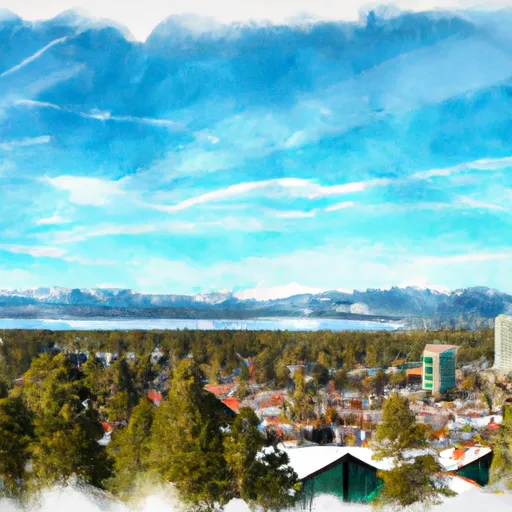-
 Snoflo Premium
Snoflo Premium
Get unlimited access to all our content
With no Ad interruptions! - Start Your Free Trial Login with existing account
South-Lake-Tahoe
Eden Index
Climate
8.3
•
Recreation
10.0
•
Community
3.8
•
Safeguard
7.8/10

South Lake Tahoe, nestled in the Sierra Nevada Mountains, is a breathtaking destination in California known for its stunning natural beauty and diverse outdoor recreation opportunities. The region experiences a Mediterranean climate with mild, wet winters and warm, dry summers. Winters bring abundant snowfall, making it a popular destination for skiing, snowboarding, and other winter sports.
The hydrology of South Lake Tahoe is dominated by the pristine Lake Tahoe, the largest alpine lake in North America. The lake is renowned for its crystal-clear blue waters and is fed by over 63 tributaries, providing a critical water source for the surrounding region. Outdoor enthusiasts can explore the lake's depths through activities like kayaking, paddleboarding, and fishing.
In addition to the lake, South Lake Tahoe offers numerous outdoor recreation opportunities. The area boasts miles of hiking and biking trails, with options for all levels of experience. The nearby Desolation Wilderness is a hiker's paradise, featuring stunning granite peaks, glacial lakes, and meadows. The region also offers opportunities for boating, golfing, camping, and wildlife viewing, making it a haven for nature lovers and adventure seekers alike.
What is the Eden Index?
The Snoflo Eden Index serves as a comprehensive rating system for regions, evaluating their desirability through a holistic assessment of climate health, outdoor recreation opportunities, and natural disaster risk, acknowledging the profound impact of these factors on livability and well-being.
Climate Health Indicator (CHI): 8.3
South-Lake-Tahoe receives approximately
818mm of rain per year,
with humidity levels near 60%
and air temperatures averaging around
7°C.
South-Lake-Tahoe has a plant hardyness factor of
6, meaning
plants and agriculture in this region thrive during a short period during spring and early summer. Most
plants will die off during the colder winter months.
By considering the ideal temperature range, reliable water supplies, clean air, and stable seasonal rain or snowpacks, the Climate Health Indicator (CHI) underscores the significance of a healthy climate as the foundation for quality living.
A healthy climate is paramount for ensuring a high quality of life and livability in a region, fostering both physical well-being and environmental harmony. This can be characterized by ideal temperatures, reliable access to water supplies, clean air, and consistent seasonal rain or snowpacks.
Weather Forecast
Streamflow Conditions
Truckee
Area Rivers
Truckee
Snowpack Depths
Truckee
Reservoir Storage Capacity
Truckee
Groundwater Levels
Recreational Opportunity Index (ROI): 10.0
The Recreational Opportunity Index (ROI) recognizes the value of outdoor recreational options, such as parks, hiking trails, camping sites, and fishing spots, while acknowledging that climate plays a pivotal role in ensuring the comfort and consistency of these experiences.
Access to outdoor recreational opportunities, encompassing activities such as parks, hiking, camping, and fishing, is crucial for overall well-being, and the climate plays a pivotal role in enabling and enhancing these experiences, ensuring that individuals can engage in nature-based activities comfortably and consistently.
Camping Areas
| Campground | Campsites | Reservations | Toilets | Showers | Elevation |
|---|---|---|---|---|---|
| Nevada Beach | 54 | 6,213 ft | |||
| Campground by the Lake | 170 | 6,256 ft | |||
| El Dorado | None | 6,255 ft | |||
| Sugar Pine Point State Park | 175 | 6,465 ft | |||
| Meeks Bay | 40 | 6,225 ft | |||
| Camp Richardson Complex | 320 | 6,250 ft | |||
| Camp Shelley | None | 6,256 ft | |||
| D.L. Bliss State Park | 170 | 6,872 ft | |||
| Fallen Leaf | 206 | 6,345 ft | |||
| William Kent | 95 | 6,337 ft |
Nearby Ski Areas
Catastrophe Safeguard Index (CSI):
The Catastrophe Safeguard Index (CSI) recognizes that natural disaster risk, encompassing floods, fires, hurricanes, and tornadoes, can drastically affect safety and the overall appeal of an area.
The level of natural disaster risk in a region significantly affects safety and the overall livability, with climate change amplifying these risks by potentially increasing the frequency and intensity of events like floods, fires, hurricanes, and tornadoes, thereby posing substantial challenges to community resilience and well-being.
Community Resilience Indicator (CRI): 3.8
The Community Resilience Indicator (CRI) recognizes that education, healthcare, and socioeconomics are crucial to the well-being of a region. The CRI acknowledges the profound impact of these elements on residents' overall quality of life. By evaluating educational resources, healthcare accessibility, and economic inclusivity, the index captures the essential aspects that contribute to a thriving community, fostering resident satisfaction, equity, and social cohesion.

